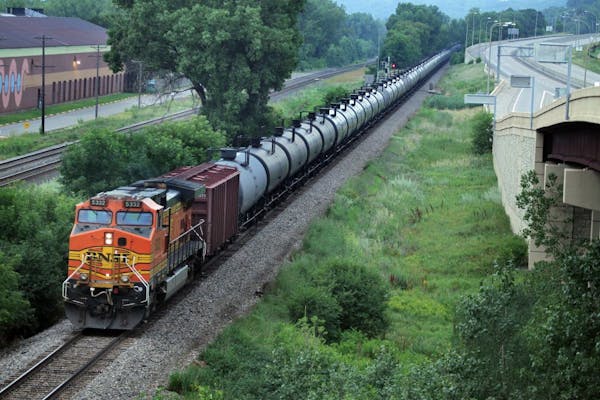North Dakota officials on Tuesday ordered the oil industry to reduce volatile gases in Bakken crude oil to make it safer to transport via oil trains.
The order by the state Industrial Commission, a three-member board that includes the governor, requires oil companies to use equipment that removes light, potentially explosive hydrocarbons before shipping. It takes effect April 1.
"This will significantly change the characteristics of [North Dakota] crude oil that's going into market," State Mineral Resources Director Lynn Helms, who oversees oil industry regulations, told the commission at a meeting in Bismarck.
About 50 oil trains, each carrying 1 million gallons or more of North Dakota crude, cross Minnesota each week — and most go through the Twin Cities. Minnesota Gov. Mark Dayton had urged the commission to impose standards to increase safety.
"We're pleased that they moved to reduce the volatility of Bakken crude oil," said David Christianson, a Minnesota Department of Transportation official who oversees freight and rail planning. "Removing a lot of light ends will go a long way toward making the oil much safer."
But Christianson said other steps also are needed to reduce the chance of oil train disasters, including proposed federal rules to strengthen tank cars and stepped-up inspections of track and equipment.
At least 15 major accidents involving crude oil or ethanol trains have occurred in the United States and Canada since 2006, including the July 2013 disaster at Lac-Mégantic, Quebec, that killed 47 people. Last December, a BNSF Railway oil train crashed near Casselton, N.D., triggering explosions, a huge fire and temporary evacuation of much of the town of 2,500 people. Just last month, an empty oil train derailed near the same city.
North Dakota oil companies opposed the oil conditioning measure, and its trade group, the North Dakota Petroleum Council, said all of the state's 11,000 wells have equipment, costing $200,000 to $400,000 per well, to condition crude oil.
In earlier testimony, Kari Cutting, vice president of the council, said North Dakota's oil has been unfairly compared to that of Texas, whose Eagle Ford shale oil is rich in petroleum condensate, a category of lighter fractions often used as refinery and petrochemical feedstocks. Condensate can be separated in a stabilization process and shipped separately in pipelines.
The North Dakota Petroleum Council had no immediate reaction to the order.
"We are taking some time to carefully analyze the order with our members and determine what implications there may be," said the group's spokeswoman Tessa Sandstrom.
The Industrial Commission is composed of Gov. Jack Dalrymple, Attorney General Wayne Stenehjem and Agriculture Commissioner Doug Goehring. In a statement, they said: "This order will bring every barrel of Bakken crude within standards to improve the safety of oil for transport."
Under the order, operators must condition Bakken crude oil to a vapor pressure of no more than 13.7 pounds per square inch. That's 1 pound per square inch lower than a national standard. Light hydrocarbons must be separated from the crude oil and can't be blended back before shipment, the commission said.
State officials plan to conduct field inspections to enforce the order, which carries a penalty of up to $12,500 for every day in violation. But the commission gave the industry nearly four months to get ready before the order takes effect.
Jim Unkenholz, a member of the Dakota Resource Council, a citizen group that lobbied for the standards, said state officials needed to take action.
"The regulations are a move in the right direction," said Unkenholz of Bismarck. "Our concern is that they must be able to implement it and have inspectors go out and check on it."
Harry Giles, managing principal of PetroStorTech LLC of Arlington, Va., and former manager of crude oil quality programs for the Strategic Petroleum Reserve, said the conditioning order comes at a time when North Dakota regulators also are trying to reduce flaring of gas at wells. Flaring, or burning off gas, typically happens when wells begin producing, before connecting gas pipelines are built.
"On the one hand you are trying to minimize flaring of gas," Giles said in an interview with the Star Tribune. "On the other hand you are stripping out an additional quantity of gases. What are you going to do with them?"
The Associated Press contributed to this report.
David Shaffer • 612-673-7090

12 gorgeous new picture books for children this spring
Metro Transit steps up safety efforts with monitors displaying bus behavior for all to see
What we know about the Sen. Nicole Mitchell burglary allegations so far
Man shot by deputy in Montrose allegedly said during earlier clash he'd rather die than be arrested

